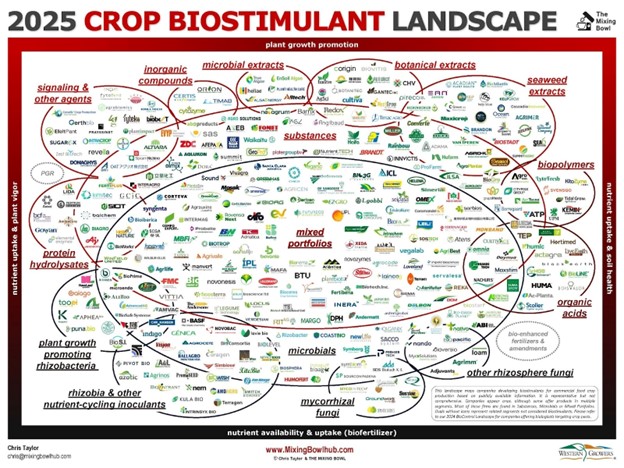The ISAP Science Committee recently invited researchers, Assistant Professor Dr. John Jones and Research Assistant Professor Dr. Connor Sible, from the University of Illinois for an in-depth conversation on the state of biologicals / biostimulants in the agricultural industry. There is growing interest within the sustainable and regenerative agriculture landscapes, and the goal of this conversation was to clarify the effects of biologicals / biostimulants based on current research and understand what role these products play in the field of conservation agriculture.
A biological or biostimulant, hereafter referred to as “biologicals,” is a substance or micro-organism that, when applied to seeds, plants, or the rhizosphere, stimulates natural processes to enhance or benefit nutrient uptake, nutrient efficiency, tolerance to abiotic stress, or crop quality and yield (2018 U.S. Farm Bill). Biologicals are sometimes confused with enhanced efficiency fertilizers (EEFs), which are designed to reduce the potential of environmental loss and improve availability for crop uptake, often by the rate of release or conversion to plant-available forms. A key demarcation between biologicals and EEFs is that biologicals are not considered fertilizers while EEFs are. The biologicals market landscape sits at around 350 companies, internationally, that provide products using rhizobia, extracts, biopolymers, organic acids, proteins, fungi, and other inoculants, with an approximate value of USD 15.29 billion in 2024 and a projected value of USD 44.70 billion by 2032 (Fortune Business Insights).

2025 marketplace of companies providing forms of biological additives in agriculture. Categories of biological additives separated by circles with companies providing multiple products in overlapping segments. Image created by The Mixing Bowl.
Even though the market and demand has been growing in the space since 2015, the research results are mixed in regard to these products providing advantages for farmers in terms of yield increases or cost savings. While the promise of enabling microorganisms or crops themselves to produce/provide nutrients is enticing, growers should be aware of what different biologicals are purported to do and how they might work within their operations. Foundational management considerations are still paramount for a functional ag operation before thinking of integrating biologicals. If there are limiting factors on your farm such as soil fertility or hydrology (drainage vs. water retention) management, those need to be addressed first, because adding a specialty input could be a costly decision that might not garner much, if any, return. Although some biologicals are showing promise, there is a need for further research to more fully understand crop performance impacts of different products using sound statistical methods that help us quantify how those impacts may vary across a field, a county, a region, and the state as well as from season to season.
Environmental Considerations
Integrating biologicals into agricultural operations has been a strategy to improve sustainability and reduce environmental impacts of agriculture. One assertion is that integrating biologicals in grass crops can be used to reduce N fertilization by around 40 lb N/ac. However, research has shown at least some of these products do not deliver on this promise in every situation (Table 5; Woodward et al, 2024). Biologicals that claim to supply around 40 lb N/ac should reflect that in studies with ranges of fertilizer rates where an 80 lb N/ac rate + biologicals would have comparable yield to a treatment with around 120 lb/N and no biologicals.
A caveat also stands that an unhealthy crop may have difficulties making associations with biologicals, which further underscores the importance of optimizing soil fertility and hydrology prior to integrating biologicals into a crop production system. Research is still slow to show conclusive results of biologicals reducing N fertilizer needs. A 2023 summary of multiple studies investigating biologicals’ nitrogen contribution to crop growth, which included 9 site-years from Illinois (2021-2022), showed only 2 of 53 site-years where the crop received a yield benefit from biologicals over the N rate effect alone (Franzen et al., 2023).

Biologicals may help expedite breakdown of corn residues and support N mineralization.
As no-till and cover crop management is used as a solution to sediment and nutrient loss, special attention to managing residue breakdown is needed to ensure limited negative yield interaction from nitrogen immobilizing residue. This has influenced the development of residue decomposing microbial products to expedite this process. Dr. Sible has seen a consistent, but very slight (~2%) increase in yield while using residue degrading applications in his research.
The addition of biologicals may increase the greenhouse gas (GHG) benefits of conservation practices (i.e. improved carbon sequestration). However, it is yet unclear whether the use of biologicals enhances GHG emissions reductions and/or soil carbon sequestration beyond the magnitude simply associated with less synthetic fertilizer use. Inputs of arbuscular mycorrhizal fungi (AMF) aid in root zone efficiency through increased surface area and nutrient acquisition, as well as promoting water retention and aggregate formation through its production of glycoproteins, but benefits and AMF networks can be quickly degraded when tillage occurs (R. Agnihotri et al, 2021). Sound conservation practices are still necessary to achieve emissions reductions or environmental benefits that may be aided by product integration.
Five considerations for farmers thinking about biologicals
- “Build the house” first. Make sure all other agronomic practices are sound before moving into biologicals.
- Prioritize the biggest nutrient-related yield losses. Correct the soil pH and provide the right amounts of phosphorus, potassium, and sulfur.
- Evaluate fertility. Nitrogen rate adjustments may help meet production and profitability goals without the need for a biological.
- Change one practice at a time. Start with a side-by-side comparison to see the impacts of biologicals rather than changing multiple practices at once.
- Know what’s in the bag. Identify the active ingredients and ask whether the mechanics (the biological “mode of action”) support the marketed benefits.
Takeaway: Good Agronomy Comes First
Biologicals and biostimulants are an intriguing addition to a farmer’s agronomic toolkit and may be integral to agriculture presently and in the future, but more research is needed to confidently identify the effect biologicals have on potential productivity and environmental benefits. Growers should maintain sound practices that work to address the yield loss mechanisms such as pH, soil-test phosphorus and potassium, or drainage in their fields and operations, as these are likely to produce a more immediate impact to profitability than biologicals. Use resources to identify optimum fertilizer inputs such as consistent soil testing programs for phosphorus and potassium or regional nitrogen fertilizer rate guidelines. These products should not be a replacement for sound agronomic practices to address pests, fertility, and hydrology, but they do show potential to be a next step that may unlock efficiencies to drive higher yields and/or profitability. Being pragmatic in your approach by enacting one change at a time to understand the impact and the mechanisms that are driving the biologicals’ function are good ways to sift through marketing claims and can help farmers evaluate potential return on investment.